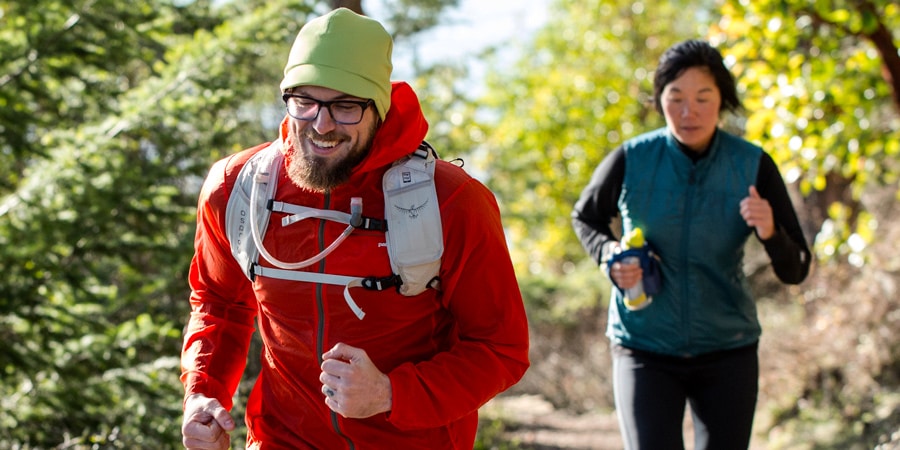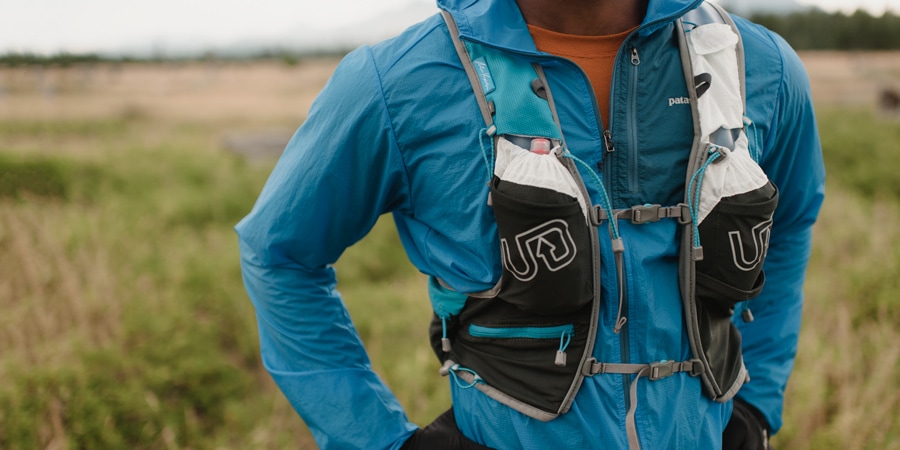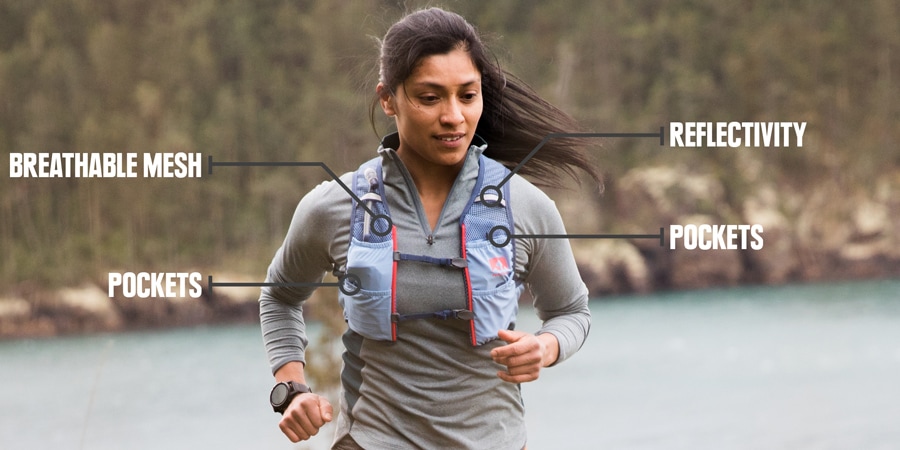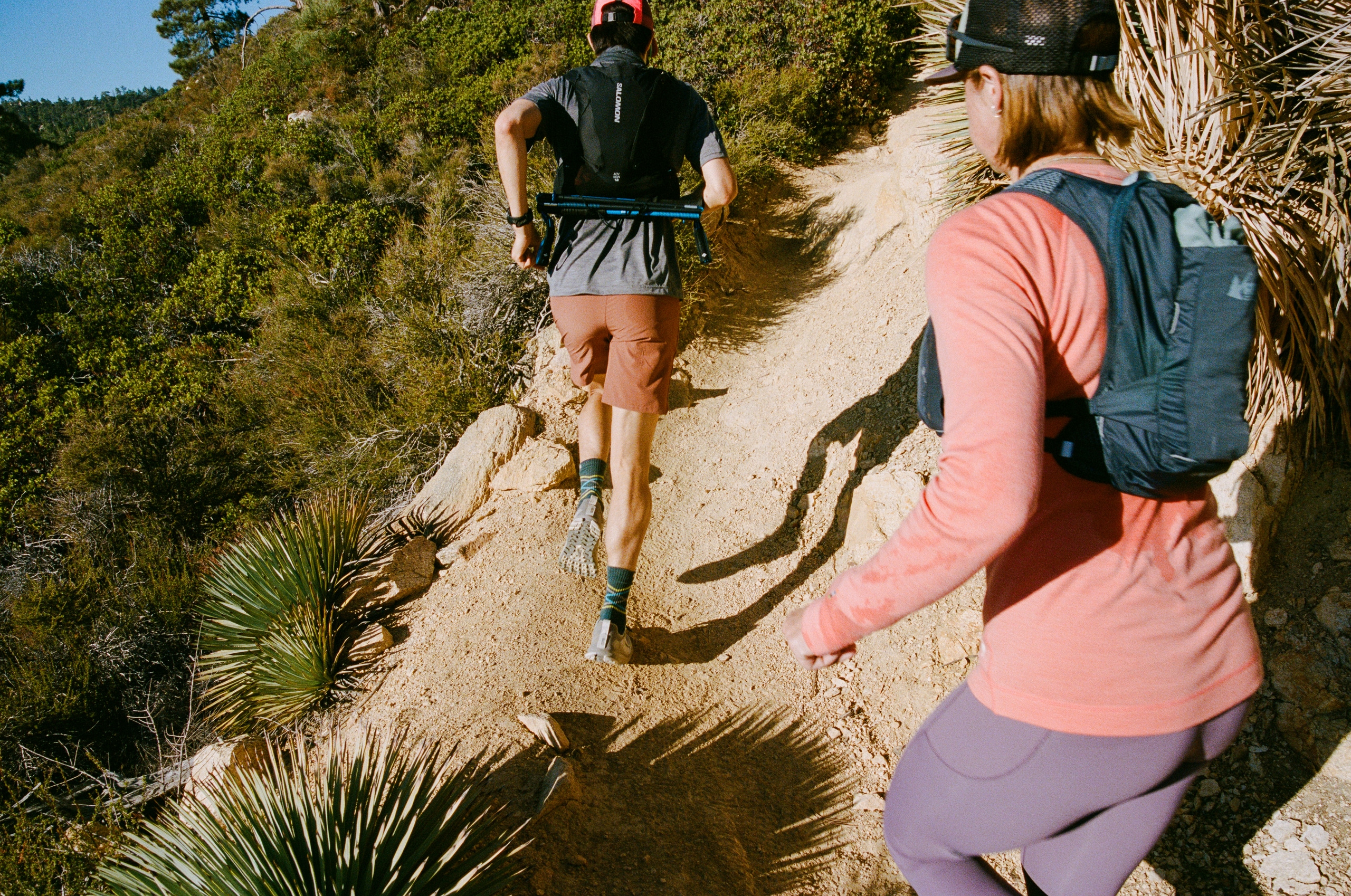It's a common sight on the trails these days: runners racing by sporting vests laden with pockets and a drinking spout or two. These running hydration vests have become popular for their ability to conveniently and comfortably carry water, food, an extra layer and any other essentials needed on longer runs (typically those lasting about 1 - 2 hours or longer).
If you're in the market for a new hydration vest, here's a quick overview of the main things you'll want to look for; then read on for more details below.
Four Steps for Choosing a Running Hydration Vest
- Choose a capacity: Make sure the running vest has enough space (measured in liters) to carry things like water, food and extra clothing. For runs lasting one to two hours, most runners need about two liters of space. For runs lasting two to three hours, you'll want a vest with a capacity between two and six liters. For runs lasting three to six hours, shoot for a vest with a capacity between four to twelve liters. And, for runs lasting six hours or longer, you'll likely need at least six liters up to the largest capacity that will fit your individual needs.
- Decide on bottles and/or a reservoir: Most vests come ready to carry water in one of two ways: in water bottles that stow on the front of the vest or in a hydration reservoir that fits into a sleeve in back. Bottles can be easier and faster to refill, but a reservoir can be simpler to sip from while on the go and it can typically hold more water.
- Get the right fit: Running hydration vests should fit snug so they don't shift around while you run. Follow the manufacturer's sizing guidelines to get the right fit.
- Look for additional features: Examine the vest for handy pockets, a built-in whistle, reflectivity, trekking pole keepers and breathability.
Ready to buy a running hydration vest? Check out our gear guide for field-tested recommendations for the Best Running Hydration Vests for every kind of run.
Running Hydration Vests: Gear Capacity

Running hydration vests come in a variety of capacities, from about two liters on up to about 12 liters or more. How much space you need depends on how much gear you plan to take along, which in turn depends mostly on how long you intend to run.
For short runs, say less than one hour, many runners will use something other than a vest, like a handheld water bottle or a small waist pack, to take along some water, a house key and maybe an energy gel. But, when your runs start going on for one to two hours or even longer, you'll probably need to take a bit more with you, like a greater amount of food and water and possibly a hat, gloves, headlamp, phone, first-aid kit and map. It's at this point that using a hydration running vest makes sense for many runners.
To choose the ideal gear capacity for you, think about how long your runs typically last and use the chart below as a starting point. (Keep in mind that exactly how big of a vest you need can be influenced by things like weather, type of run and personal preference.)
| Run Duration | 1 - 2 hours | 2 - 3 hours | 3 - 6 hours | 6+ hours |
|---|---|---|---|---|
| Vest Gear Capacity | 2 liters | 2 - 6 liters | 4 - 12 liters | 6+ liters |
If your runs vary in duration dramatically, it might seem like you need to own more than one running hydration vest. This may be feasible for some runners, but for many people it's more practical to have one vest for all their runs. In this case, select a vest that's large enough to cover all your needs, but be aware that a lot of excess space can cause the vest to move around more while you're running. Read some tips on how to stay hydrated while running.
Running Hydration Vests: Water Bottles vs. Reservoirs

An important decision when choosing a hydration running vest is how you want to carry your water. Most vests come set up to carry water in one of two ways: in water bottles that stow on the front of the vest or in a hydration reservoir that fits into a sleeve in back. Which you choose is partially based on personal preference; some runners simply don't like the feel of the extra weight of water on their backs so they'll use bottles up front while other people prefer to sip from a reservoir tube and aren't bothered by the weight in back.
To help you decide which is best for you, here are several things to consider:
Most vests are compatible with bottles and a reservoir: Whether the vest you buy comes with one or two bottles or a reservoir, it's most likely designed to be able to carry bottles and a reservoir at the same time. This can be reassuring because it means you can adapt most vests to carry water the way you want even if you don't know which way that is when you initially purchase a vest.
Bottles are easier and faster to refill: If you're doing a long run that will require you to refill partway through, you'll find that taking the bottles out of the vest, filling them and sliding them back in is much easier and faster than removing the reservoir.
Bottles can be soft or rigid: Many hydration vests come with soft, flexible water bottles that conform to your body for comfort and limit water sloshing. However, the flexible nature of these bottles makes them susceptible to being punctured if you take a fall, which is one reason some runners, especially those who explore remote areas, prefer to use rigid bottles.
Reservoirs hold more water: For longer runs that require more water, a hydration reservoir will generally give you more liquid capacity. For really long runs, you might want to use a reservoir together with bottles (most vests allow you to carry water both ways). How much liquid you need to carry depends mostly on the duration of your run, the outside temperature and if you'll be able to refill along the way. In general, you're going to need to carry enough water to be able to drink five to 10 fluid ounces (a few good long drinks) every 15 - 20 minutes. To learn more about how much water to carry while running, see our article Hydration Basics for Trail Running.
Tip: If you choose to carry water in a reservoir, here's a quick tip to help reduce sloshing while you're running. After filling the reservoir and putting it into your vest, turn the vest upside down and suck on the tube to remove excess air before you start running.
Bottles add versatility: Many runners like to drink electrolytes or consume liquid calories while they're running, but they also want some plain water to sip on. Using two bottles or a combination of bottles and a reservoir allows you to store different liquids in different places. For instance, you could fill one bottle with an electrolyte mix and the other bottle or the reservoir with plain water. Bottles also allow you monitor how much water you've consumed more easily than with a reservoir that's stowed in back.
Bottles and reservoirs aren't always included: Not all vests come with bottles and/or reservoirs even if they're compatible with them. Read the product description when purchasing to know exactly what you're getting.
How to Find the Right Size Hydration Running Vest

Finding a running hydration vest that moves with you and fits you well is key; an improperly fitting vest can bounce around while you're running and cause painful chafing. Here are several ways to ensure you get a good-fitting vest:
Follow the manufacturer's sizing guidelines: Hydration running vest manufacturers often provide specific sizing guidelines on their websites to help you get the right fit. For example, they commonly list body measurements, such as bust circumference, sternum circumference and/or ribcage circumference, and include a chart that shows their corresponding vest sizes based on those measurements. If you follow these guidelines closely, there's good chance you'll find a vest that fits you well (Note: fit guidelines tend to vary from one manufacturer to the next, so make sure to look up the instructions for the particular vest you're interested in).
Choose a snug fit: Running vests are meant to fit quite snug to limit movement while running. When a vest is too big, it will tend to shift around, which can be distracting and uncomfortable, especially if the movement causes painful chafing (learn more about preventing chafing). When you try a vest on, take a look for excess fabric around the shoulders or where the vest wraps underneath your arms. If it's loose there, you might want to try a smaller size. If the vest feels restrictive or uncomfortable when you take deep breaths (like you'll do when huffing and puffing up a trail), then it might be too small. If you're trying the vest on at an REI store, work with a sales specialist to load the vest up with weight to get the most accurate feel for how it fits.
Leave room for adjustment: Pay attention to any adjustable straps on the vest, such as ones that go across your chest or underneath your arms. With the vest on and ready to go, these straps should be approximately at the middle of their adjustment range. If they're at one extreme or the other, then you might have the wrong size.
Women-specific vests: Many women benefit from selecting a women-specific vest. Women's hydration packs for running tend to have more room in the bust and narrower shoulders while also being cut shorter overall.
Additional Features on Running Hydration Vests

Running hydration vests come with a variety of different features that can make them more convenient and comfortable. Here are some features to keep an eye out for while you're choosing a running hydration vest:
Pockets: Most vests include a variety of pockets to hold frequently used items, like gels, your phone and an extra layer. Take a look at the positioning of the pockets and make sure they're easy to reach; ideally you don't have to stop moving to grab a jacket or reach an energy gel. Also, consider the pocket closures. Zippers on pockets ensure important items don't fly out when you stumble on the trail, but they're usually a bit harder to get in and out of than a stretchy pocket.
Reflectivity: Many vests include reflectivity to help you be seen during nighttime runs, whether that's by oncoming traffic or fellow runners wearing headlamps.
Breathability: Most vests are built with a good amount of breathability, but you might want to look for this specifically if you tend to run hot. Look closely at the back panel and the straps that wrap around the front for mesh materials that improve breathability.
Emergency whistle: Some vests include a whistle on a sternum strap. This can be a handy emergency item to have in case you need to alert someone to your location.
Trekking pole keepers: If you like to use trekking poles while you're out on the trails, you might want to use a vest that has a dedicated spot for securing them.


